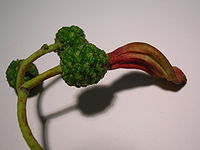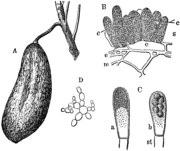
Taphrina pruni
Encyclopedia
Taphrina pruni is a fungal plant pathogen that causes the Pocket or bladder Plum gall, a chemically induced distortion of the fruit, producing swollen on one side, otherwise deformed and flattened fruit gall
without a stone. The twigs on infected plants may also be deformed with small strap-shaped leaves.
on Bird Cherry Prunus padus. The growth is the distorted fruit and not a fungus in its entirety.
T. pruni is also found on Bird Cherry (Prunus padus), Almond (Prunus amygdalus), Peach and Nectarine (Prunus persica). The Mirabelle
or Greengage
varieties of Prunus domestica may be more resistant.
In Britain the gall forms in June, reaches its full size in July / August and persists to September, some overwintering, but most falling.
s. Some authors suggest these are caused by the very similar Taphrina insititia, others that this is only a form of Taphrina pruni.
 The airborne spores released from the whitish 'bloom' on the fruit are thought settle in the hosts bark and bud scales, growing at first without causing obvious signs, but in the spring the fungus invades the plant tissues, causing swollen and deformed shoots. The fungus remains in these as a mycelium. The gall inducing fungus then grows into the flowers and the developing fruit. The cycle then repeats itself.
The airborne spores released from the whitish 'bloom' on the fruit are thought settle in the hosts bark and bud scales, growing at first without causing obvious signs, but in the spring the fungus invades the plant tissues, causing swollen and deformed shoots. The fungus remains in these as a mycelium. The gall inducing fungus then grows into the flowers and the developing fruit. The cycle then repeats itself.
The fungus infects the ovaries causing a pseudo-pollination and an enhanced cell division, resulting in the infested fruit being larger than the healthy one.
 As a fungus, cool and wet weather conditions promote the germination of spores, whilst warm and dry weather results in infection rarely taking place.
As a fungus, cool and wet weather conditions promote the germination of spores, whilst warm and dry weather results in infection rarely taking place.
Colonisation can become extensive and eradication very difficult. The disease can to some degree be controlled by carefully removing infected branches, witch's brooms and fruit before the infective air borne spores are produced.
Applications of copper-containing fungicides have a degree of control over the fungus.
Gall
Galls or cecidia are outgrowths on the surface of lifeforms caused by invasion by other lifeforms, such as parasites or bacterial infection. Plant galls are abnormal outgrowths of plant tissues and can be caused by various parasites, from fungi and bacteria, to insects and mites...
without a stone. The twigs on infected plants may also be deformed with small strap-shaped leaves.
Hosts
T. pruni produces a distinctive tongue-like growth, similar to other closely related species such as Taphrina alni on Alder (Alnus glutinosa) and Taphrina padiTaphrina padi
Taphrina padi is a fungal plant pathogen that induces the form of Pocket Plum gall that occurs on Bird Cherry . The gall is a chemically induced distortion of the fruits, which are swollen, hollow, curved and greatly elongated, without a seed or stone, but retaining the style...
on Bird Cherry Prunus padus. The growth is the distorted fruit and not a fungus in its entirety.
T. pruni is also found on Bird Cherry (Prunus padus), Almond (Prunus amygdalus), Peach and Nectarine (Prunus persica). The Mirabelle
Mirabelle plum
The mirabelle plum, also known as the mirabelle prune , is the edible drupaceous fruit of the mirabelle prune tree, a cultivar of the plum tree of the genus Prunus...
or Greengage
Greengage
The greengages, also known as the Reine Claudes, are the edible drupaceous fruits of a cultivar group of the common European plum. The first true greengage was bred in Moissac, France, from a green-fruited wild plum originally found in Asia Minor; the original greengage cultivar nowadays survives...
varieties of Prunus domestica may be more resistant.
Distribution
The gall is widely distributed, under recorded in the United Kingdom, but found throughout the temperate Northern Hemisphere.Fruits
The gall is usually known as 'pocket plum', however alternatives are 'starved plum'; 'bladder bullace; and 'mock plum'. The gall appears on the developing fruit, rendering it inedible and resulting in an elongated, flattened, hollow, stone-less gall of any colour from light green, through grey to light orange. The surface of the gall becomes corrugate and coated with the fungus, showing as a white bloom of ascospore producing hyphae. The totally inedible fruits shrivel and most fall.In Britain the gall forms in June, reaches its full size in July / August and persists to September, some overwintering, but most falling.
Stems
Stems bearing deformed fruit may also thicken and grow with a deformation. The leaves are smaller and strap-like and shoots may be swollen, pale yellow and tinged with red. The fungus may also cause dense clusters of live and dead twig, called witch's broomWitch's broom
A Witch's broom is a disease or deformity in a woody plant, typically a tree, where the natural structure of the plant is changed. A dense mass of shoots grows from a single point, with the resulting structure resembling a broom or a bird's nest....
s. Some authors suggest these are caused by the very similar Taphrina insititia, others that this is only a form of Taphrina pruni.
Life cycle

The fungus infects the ovaries causing a pseudo-pollination and an enhanced cell division, resulting in the infested fruit being larger than the healthy one.
Infestations of galls

Colonisation can become extensive and eradication very difficult. The disease can to some degree be controlled by carefully removing infected branches, witch's brooms and fruit before the infective air borne spores are produced.
Applications of copper-containing fungicides have a degree of control over the fungus.
Sources
- Darlington, Arnold (1975). The Pocket Encyclopaedia of Plant Galls in Colour. Poole : Blandford Press. ISBN 0-7137-0748-8.
- Redfern, Margaret & Shirley, Peter (2002). British Plant Galls. Identification of galls on plants & fungi. AIDGAP. Shrewsbury : Field Studies Council. ISBN 1-85153-214-5.
- Stubbs, F. B. Edit. (1986). Provisional Keys to British Plant Galls. Pub. Brit Plant Gall Soc. ISBN 0-9511582-0-1.

